Lilly Daché (1898-1989) is one of my favorite vintage hat designers. I like her style: bold design, colorful fabrics, ornate detail, and sometimes flowery.
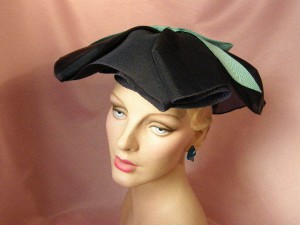
I had wanted to read her out-of-print autobiography for some time. But I couldn’t find a copy at an affordable price, which is nowhere near the $100+ internet sellers were asking. That is until recently when I finally tracked down a used library copy from Arkansas. Lilly’s book, like her hats, is quite a delight!
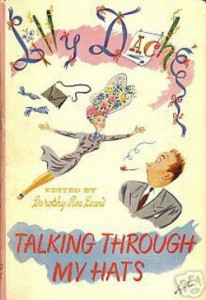
One of her reasons for writing the book:
“I want to put down the love I have for this big and busy and openhearted country.”
One of my favorite lines:
“For every hat there is a woman to wear it, and for every woman there is a story.”
During the times in which Lilly grew up in France, a girl’s number one goal was to get married. This was easier to achieve if the girl were pretty and/or rich. Lilly says she was neither.
She made her first hat when she was six years old—by cutting up one of her mother’s blouses. She continued to design hats, clothes, and hairdos. At age ten she dreamed of going to America to work in the fashion industry. By the time she was thirteen, she said:
“I knew that here was the thing I wanted to do. I would make hats that would make women beautiful, and maybe I could make myself beautiful, too.”
(This was in 1911. I guess women’s dissatisfaction with their looks goes way back–like maybe since the beginning of time?!)
After serving an apprenticeship at her aunt’s millinery shop, she set sail for America at the age of eighteen. She arrived with thirteen dollars in her purse—but no English in her vocabulary. She first stayed with her cousin in New Jersey, then moved to Philadelphia, and finally to New York at age twenty.
In New York she quickly found a job as a milliner that led to a position in the hat department at Macy’s. With her outspoken personality, she had several run-ins with her floor supervisor over how to best serve customers. After one altercation with her supervisor, Lilly figured she was going to get fired. So she raced to the Big Boss’s office to resign before that could happen.
Lilly explained why she was leaving. The Big Boss was sympathetic and told her she could stay, but that he honestly felt Macy’s was not the place for her to forge a career. He said, “You can do better.”
Lilly took those words to heart, left Macy’s crying, but never looked back in regret.
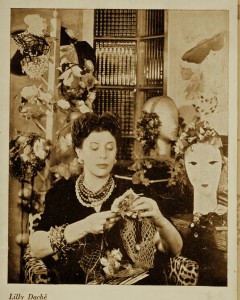
The middle of the book Lilly talked about some of her famous clients and then meeting her future husband Jean (a French executive with Coty). Their courtship began as a “he plays aloof” and “she plays hard to get.”
She also dated a Texan named Sam during this time, and much preferred the way Sam treated her, “like a Queen at all times.” Sam showed her respect; Jean showed her he was spoiled. Sam did not look down on her. Jean patted her on the head.
On Page 131:
“I decided I did not like this Old World attitude. I had earned that right to be an American, and to be treated as American girls are treated…as an equal. As a comrade. Not as someone…to be dismissed at will.”
But I guess the course of true love does not run smoothly, as she married Jean, and had a long-lasting marriage (with one daughter, Suzanne). The secret to her marriage:
Page 153:
“Some of my friends have said they do not see how I can divide myself so completely, and make a success of both a career and a marriage. I have told them that it is because I work at both jobs…and I know always that being a wife is most important, if there must be a choice….so to my home I give my undivided attention when I am there, and to my work I give all my energy—and this is considerable—when I am working. It is a strenuous life….”
During her prime (1930s-60s), Lilly was the most famous hat maker in the U.S. She had the top echelon of society and Hollywood as her clients. She had a building on Park Avenue with her name on the outside and hundreds of employees. Most important, she was doing what she loved.
During her stint at Macy’s, her supervisor asked her, “What is a hat?” He did not let her respond. His answer was: “A hat is a crown and a brim.”
Had Lilly been allowed to speak, she would have said:
“A hat is an expression of a woman’s soul. It is something that she wears on her head, but it belongs to her heart. It is the keynote of her personality, the finishing touch that makes her look beautiful, smart, and sure of herself.”
That is my philosophy about fashion in general. To me, creepy clothes = a creepy opinion about oneself. Consequently, no raggedy clothes for me! (Ditto for shoes.)
Here’s the terrific ending of Lilly’s book (Page 265):
“…I know I have followed my own recipe for happiness—to do what you love, with people you love, in the place that you love. That’s all.”
And that’s a lot.
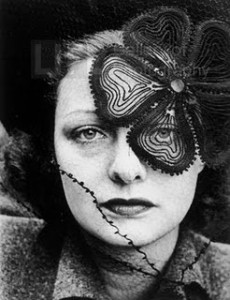
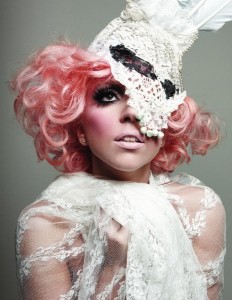

what fun to read your “book report” I am a member of Library Friends and of the local Red Hat society. a lot of my friends do not like wearing red hats or any other hats. I didn’t know her, but knew my grandmother was a milliner and her daughters loved their hats. I do too and have a small collection, several of them red. I always have the right one to loan a friend. One pillbox I made from an oatmeal box covered in veveteen for a bellhop costume then covered it with red feathers when I wanted an evening hat. Also made a high crown for a military brimmed hat when my husband was the toy soldier in a Christmas presentation. My mother took the pale blue-grey feathers from Pheasants and made a hat from them when that style hat was in vogue.
Cool web site, I had not noticed fuchsiawoman.com before in my searches!
Carry on the great work!
Awesome website. I loved reading your info
Wonderful posts about Lily. Not many people know who she is but I like her hats. Your book reports were fun to read.
Thank you!
I have just found Lilly! and I already can’t read enough about
her hats & life. Nice repot! I’m already a big fan of both Lily and you website. Keep ’em coming!
Hi Susan,
I’m a big Lilly fan, too — have several of her vintage hats. I’ve written two other blogs about her: on 1/14/10 and 11/19/10. I also bought a bottle of her signature perfume. A little too powerful (stinky?) for me!